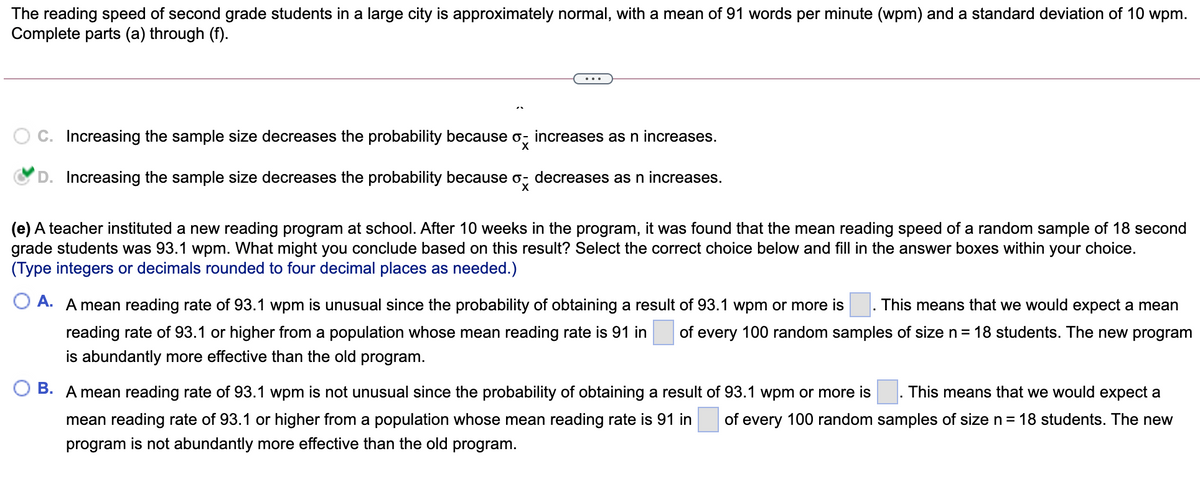The reading speed of second grade students in a large city is approximately normal, with a mean of 91 words per minute (wpm) and a standard deviation of 10 wpm. Complete parts (a) through (f). O C. Increasing the sample size decreases the probability because o, increases as n increases. D. Increasing the sample size decreases the probability because o; decreases as n increases. e) A teacher instituted a new reading program at school. After 10 weeks in the program, it was found that the mean reading speed of a random sample of 18 second grade students was 93.1 wpm. What might you conclude based on this result? Select the correct choice below and fill in the answer boxes within your choice. Type integers or decimals rounded to four decimal places as needed.) O A. A mean reading rate of 93.1 wpm is unusual since the probability of obtaining a result of 93.1 wpm or more is This means that we would expect a mean reading rate of 93.1 or higher from a population whose mean reading rate is 91 in of every 100 random samples of size n = 18 students. The new progran is abundantly more effective than the old program. O B. A mean reading rate of 93.1 wpm is not unusual since the probability of obtaining a result of 93.1 wpm or more is This means that we would expect a mean reading rate of 93.1 or higher from a population whose mean reading rate is 91 in of every 100 random samples of size n= 18 students. The new program is not abundantly more effective than the old program.
The reading speed of second grade students in a large city is approximately normal, with a mean of 91 words per minute (wpm) and a standard deviation of 10 wpm. Complete parts (a) through (f). O C. Increasing the sample size decreases the probability because o, increases as n increases. D. Increasing the sample size decreases the probability because o; decreases as n increases. e) A teacher instituted a new reading program at school. After 10 weeks in the program, it was found that the mean reading speed of a random sample of 18 second grade students was 93.1 wpm. What might you conclude based on this result? Select the correct choice below and fill in the answer boxes within your choice. Type integers or decimals rounded to four decimal places as needed.) O A. A mean reading rate of 93.1 wpm is unusual since the probability of obtaining a result of 93.1 wpm or more is This means that we would expect a mean reading rate of 93.1 or higher from a population whose mean reading rate is 91 in of every 100 random samples of size n = 18 students. The new progran is abundantly more effective than the old program. O B. A mean reading rate of 93.1 wpm is not unusual since the probability of obtaining a result of 93.1 wpm or more is This means that we would expect a mean reading rate of 93.1 or higher from a population whose mean reading rate is 91 in of every 100 random samples of size n= 18 students. The new program is not abundantly more effective than the old program.
Glencoe Algebra 1, Student Edition, 9780079039897, 0079039898, 2018
18th Edition
ISBN:9780079039897
Author:Carter
Publisher:Carter
Chapter10: Statistics
Section10.4: Distributions Of Data
Problem 19PFA
Related questions
Question
The reading speed of second grade students in a large city is approximately normal, with a mean of 91 words per minute (wpm) and a standard deviation of 10 wpm. Complete parts (a) through (f).

Transcribed Image Text:The reading speed of second grade students in a large city is approximately normal, with a mean of 91 words per minute (wpm) and a standard deviation of 10 wpm.
Complete parts (a) through (f).
C. Increasing the sample size decreases the probability because o, increases as n increases.
D. Increasing the sample size decreases the probability because
decreases as n increases.
(e) A teacher instituted a new reading program at school. After 10 weeks in the program, it was found that the mean reading speed of a random sample of 18 second
grade students was 93.1 wpm. What might you conclude based on this result? Select the correct choice below and fill in the answer boxes within your choice.
(Type integers or decimals rounded to four decimal places as needed.)
O A. A mean reading rate of 93.1 wpm is unusual since the probability of obtaining a result of 93.1 wpm or more is
This means that we would expect a mean
reading rate of 93.1 or higher from a population whose mean reading rate is 91 in
of every 100 random samples of size n= 18 students. The new program
is abundantly more effective than the old program.
B. A mean reading rate of 93.1 wpm is not unusual since the probability of obtaining a result of 93.1 wpm or more is
This means that we would expect a
mean reading rate of 93.1 or higher from a population whose mean reading rate is 91 in
of every 100 random samples of size n = 18 students. The new
program is not abundantly more effective than the old program.
Expert Solution
This question has been solved!
Explore an expertly crafted, step-by-step solution for a thorough understanding of key concepts.
This is a popular solution!
Trending now
This is a popular solution!
Step by step
Solved in 2 steps with 1 images

Recommended textbooks for you

Glencoe Algebra 1, Student Edition, 9780079039897…
Algebra
ISBN:
9780079039897
Author:
Carter
Publisher:
McGraw Hill

Glencoe Algebra 1, Student Edition, 9780079039897…
Algebra
ISBN:
9780079039897
Author:
Carter
Publisher:
McGraw Hill